 |
 |
Paris traffic lights have a secondary set of lights at driver level. Here we see both classical and modern examples.
Driving in Paris seems a little different to the UK - lights go from red directly to green and priority on roundabouts is with those joining the roundabout instead of those already on it.
Last year we saw lingerie posters everywhere - this year it was a magazine cover! |
 |
 |
The coach dropped us off next at the Palais de Chaillot. Built for the 1937 World Fair, the museum's lines and statues were shrouded in scaffolding and boarding.
However the courtyard presents a superb view of the Eiffel Tower across the fountains and gardens of the Trocadero.
Also built for a World Fair - this time in 1889 - it opened to vitriolic criticism for its ugliness. The public, though, did not and still do not agree. Four million visitors a year endure the queues which are as impressive as the structure... |
 |
 |
Where the coach stopped - in fact almost anywhere where a coach can stop in Paris - there were groups of mainly coloured men selling postcards, scarves, rugs, you name it. It is a cheap way to buy postcards.
Mum and Dad were more interested in the wares of this stall. Then it was back into the coach and wave at the nice men with the guns outside the embassies and Government buildings! |
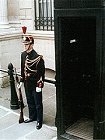 |
 |
It must be the in thing of the Millenium to have a big wheel. On a more modest scale than the London Eye, this wheel stood out against the dramatic sky over the Place de la Concorde.
The Obelisk was a gift from the Viceroy of Egypt in 1829 and is 3,300 years old. It is fond of the figure 2... There are two 3s and two zeros in its age and it weighs 220 tons and took two years to move from Egypt to France and then two years from Toulon to Paris. |
 |
| The Place de la Concorde was more gruesomely, the Place de la Guillotine during the Revolution.
The guillotine stood before the statue of Brest, one of eight statues of towns of France in the square.
It replaced a statue of a previous king, Louis XV which was not to the liking of the revolutionaries. The King himself, Louis XVI lost his head here, in January 1793. Paris was not a healthy place for royalty or the aristocracy in those dangerous times.
Happily, the only revolutions during our visit were those of the Big Wheel. |
 |
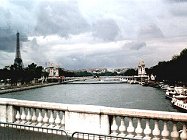 |
Well, almost anyway! Paris, as do most capitals of the western world, has its share of protests. |
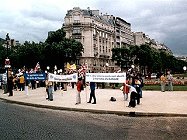 |
 |
Ah... lunchtime!
The sweet things are very tempting and diets and holidays don't always mix! |
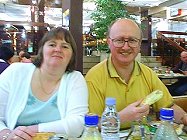 |
 |
With our lunch we are serenaded by that most recognisably french sound - the piano accordian. |
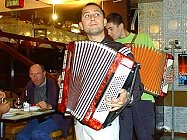 |
|